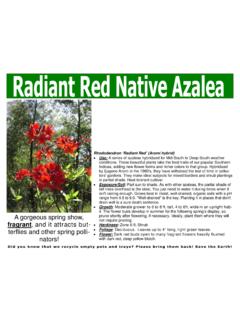Transcription of 20 Native Trees to Plant - iowanativetreesandshrubs
1 20 native trees to plant Permission granted to use artwork from the following publications: Native Trees for Urban and Rural America, Gary L. Hightshoe Forest Trees of Illinois, Illinois Department of Natural Resources Other illustrations by Mark Muller Equal opportunity to participate in, and benefit from, the programs and activities of the Iowa Department of Natu- ral Resources is available to all individuals regardless of race, color, national origin, disability or age. If you be- lieve you have been discriminated against in any program, activity or facility as described above, or if you desire further information, please write to: Director, Iowa De- partment of Natural Resources, Wallace State Office Build- ing, 502 E.
2 9th St., Des Moines, Iowa 50319-0034. 20 native trees to plant Introduction If you have ever flown in an airplane over Iowa, you would see that our woodlands Table of Contents are scattered along the rivers and streams and areas too steep to farm. You would also see a green carpet of Trees within out cities and towns. Did you know that 90% of the over million acres of forest in Iowa is owned by over 138,000 different private The Secret Life of Trees .. Page 1 owners? Or that 30% of the land cover in a typical Iowa community is covered by American Hornbeam.
3 Page 3 Trees ? Trees are vital for the protection of our drinking water supply, critical for wildlife Hophornbeam .. Page 4 habitat, and help sustain employment of over 7,000 Iowans in the wood products Black Maple .. Page 5 industry. This booklet 20 native trees to plant will help you gain a greater knowledge Bur Oak .. Page 6 about Iowa's Trees and forests. I think I shall never see a poem as lovely as a tree was Chinkapin Oak .. Page 7 written by a World War 1 soldier, Joyce Kilmer over 80 years ago. The interest and love Northern Pin Oak .. Page 8 of our Trees continues for many of us today.
4 Learn about and enjoy Iowa's Trees . Red Oak .. Page 9 Consider ways that you can improve our environment by planting and caring for Shingle Oak .. Page 10 Iowa's Trees and forests. Enjoy! Swamp White Oak .. Page 11. White Oak .. Page 12 The Secret Life of Trees Basswood/Linden .. Page 13 It Starts with Seeds Cockspur Hawthorn .. Page 14 Seeds look and feel very differently from each other, but they're all alike in important Downy Serviceberry .. Page 15 ways. Each of them is a baby Plant with its own food supply, all put together in one Hackberry.
5 Page 16 handy, self-sealing package. They all have the same needs for growth: moisture, warmth, Kentucky Coffeetree .. Page 17 sunlight, food, and air. And they begin to grow in much the same way: moisture soaks Nannyberry .. Page 18 the outer shell of the seed until it becomes soft, the food inside expands as the water enters the seed. If warmth is also present, the shell breaks open and growth begins. Ohio Buckeye .. Page 19 A seed contains everything that's needed to form a new Plant . As growth begins, Pagoda Dogwood .. Page 20 a small root pushes out of the seed and down into the earth to search for water.
6 A tiny Shagbark Hickory .. Page 21 stem pushes up through the soil reaching toward the sunlight. Witchhazel .. Page 22 As the Plant grows underground, it uses the food stored in the seed. As soon as Right tree , Right Place .. Page 23 it pushed out of the ground into the sunlight, it begins to make its own food. Food is make by the leaves' tissues chlorophyll acting together with water, air and sunlight Native Trees of Iowa Chart .. Page 26 to make the kind of sugar that is food for the Plant . The youngest tree that grows from a seed is called a seedling.
7 After a tree reaches The Iowa Department of Natural Resources provides a variety a height of six feet or more and its trunk is one of two inches thick, it is called a sapling. of services to landowners interested in tree planting, forest The tree continues to grow as long as it lives. land management, and much more! To obtain a list of District Foresters and the counties they serve, contact: Where Growth Takes Place Iowa DNR Forestry Bureau Wallace State Office Building Trees have three different growing parts: the root tips, the wood layers, and the buds.
8 The root tips cause the roots to grow longer and spread out in search of more Des Moines, IA 50319. water and minerals. The wood layers are the inside of the tree , under the bark. You'll (515) 281-8681. find wood layers in the trunk and limbs. The buds of the limbs grow longer, making the tree taller and wider. This also makes it possible for the limbs to spread out to receive more sunlight. 1. By looking at the cross-section of a tree trunk, you can see tree growth from the American Hornbeam center toward the outside. Look closely at the top of a stump or the end of a log, and you can see rings in the wood.
9 These rings are made by growing layers of wood; a new layer of wood is added each year. Each layer is made up of a band of lighter colored wood called spring wood and a band of darker wood called summer wood. The spring wood band is usually wider than the summer wood band. They are called annual rings. Leaves: Simple, alternate two and one-half to five inches long, oval, rounded or heart-shaped, sharply and doubly serrate. Seasons Come, Seasons Go Buds: Small, one-sixth to one-fourth inches long, narrowly ovate to oblong, Seasonal changes bring a lot of variety to a forest.
10 During the spring of the year, pointed, reddish-brown-black, slightly forest life is renewed. The flowering plants , including many Trees and shrubs, display hairy often downy on edges, frequently their showy flowers. The broadleaf Trees and shrubs bud out, then begin to cover with woolly patch of down on tip. themselves with new leaves. The evergreens develop new shoots later flare out into Bark: Smooth, thin, dark bluish gray, the new stems and needles. fluted with smooth, rounded longitudinal During late spring and summer, all the new life that began in the spring is growing ridges.




